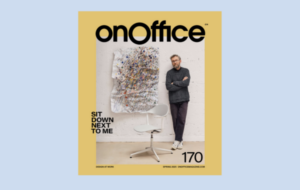
 Many architecture, design and fit-out firms dream of securing blue-chip clients. The money’s better, there’s more regular business and the build is perceived as more spectacular.
Many architecture, design and fit-out firms dream of securing blue-chip clients. The money’s better, there’s more regular business and the build is perceived as more spectacular.
But how do you net a big client, keep it when it’s netted and – can you even handle it?
We asked successful architects with decades of experience with the big players and people on the other side of the fence – those who commission the design work – what your firm needs to do to stand out. And what can go wrong. Their answers may surprise you.
Linda Morey Smith, principal director, MoreySmith
Think of your clients as individuals. If you find an individual you like to work with – whoever it is – it makes it much easier for everyone. That said, if you are going to make friends with someone, remember a CEO or finance director can make decisions more easily and quickly.
Developers are even better to work for than corporate clients – they use you over and again rather than every five to ten years!
Stay in touch by all means, but make it friendly. If I thought that every time I was calling a client it was for a new piece of business, I’d never call.
Keep track of your contacts – they move up within companies or they move out altogether. Who is their replacement?
Sharon Turner, principal, Swanke Hayden Connell Architects
Avoid corporate clients who see you as the same as any other vendor and are just trying to slash costs. They view design as throwaway and aren’t convinced of its value. But sacrificing your profit means you won’t be able keep your top people on the job, the work might be substandard, the client relationship will be strained and your legacy will be impaired. What is the job worth to you?
Be prepared to do a fair amount of mundane work on the road to an 18,000sq m building. There’s disability access, planning consent and that vent to put in – but avoid contracting it out. Once lost, client trust cannot be regained.
Concentrate on getting to know the people who don’t like you rather than people who do. Then, when the old man runs off with his secretary, you will still be under consideration for the next commission.
Be aware that in quiet periods a client will get used to immediate service. This has serious implications for your resource planning, as during your busiest times, they will also want to speak to someone immediately.
Ride the wave. There is always a dip in the middle of a long job. I call it the three-year itch, when people get jaded after the initial creative buzz fades. But things pick up towards the end and morale rises again.
Be results driven: corporations respond well to this and if you can prove that design work has improved productivity or HR can say attendance has gone up, you’ll have won their heart.
Don’t expect to be treated as an equal: often I have got into a plane and turned right into coach while the client turns left into business.
Sara Fox, director, Fox&Co Consulting (formerly project manager at 30 St Mary Axe)
First impressions are vital. Miss the pre-qualification deadline? Bad move. If you can’t even make that, how are you going to be feet to the fire? That’s two demerit points. And I have a very strict rule – two typographical errors in your document and it goes in the bin. This is detail and what’s design all about? Detail!
Dress right: don’t turn up to the presentation in the slobby clothes you wear around the office. I’m not interested in seeing your belly-button piercing. Go to Top Shop and spend £80! Firms who have the good sense to put their people in business suits with ties, brush their hair and hide the facial shrapnel have a better chance.
Don’t underestimate the importance of the job to the client. Whether it’s for a small advertising firm or a large bank, the client is getting ready to spend what is for them a lot of money. If you don’t appear as if you can play by the client’s rules or, at least, appear empathetic, then they won’t listen to you.
“Most clients are clueless”: design firms believe this is true. They are not wrong for the most part. But don’t treat clients as though they are clueless. Don’t come over all “Boy, are you clueless, but don’t worry, we’ll sort you out!” The client is trying hard to articulate what they want but lacks the vocabulary to express it. They know what they don’t like about where they are now but can’t take it to the next level. Your job is to reflect back what you think you have heard them say in a positive manner.
If you have a brilliant designer who is rude and obnoxious, keep him chained to his desk. It’s all about bedside manners.
Work with the client during the preparatory stages. It’s a very bad idea to hide yourself away in a room for three weeks on end with no contact with a client, then pull a rabbit out of a hat in the presentation at the last minute. You could miss something huge like the CEO’s dislike of green. So if you pull a green rabbit out of a hat it’s going to be a huge blooper – shock and dismay. Instead, when the rabbit comes out of the hat baby blue with a dinner jacket on, they are ready for it and think it’s a good idea.
Richard Kauntze, chief executive, British Council for Offices
Corporate clients are different from SMEs. They will have a dedicated team looking at property issues, and be certain about what they are expecting in terms of results, timing and price. A big client will be looking internationally at things like outsourcing projects in India. They operate in a fast-changing environment and want things to be implemented in a fast-changing way.
Any professional services team would be mad not to talk about people issues. Big companies are increasingly focused on people.
Develop lasting relationships: corporations have the potential to provide large amounts of repeat business, so get to know about what makes the company different, what works and what works less well, economies of scale and replicating ideas that have worked elsewhere.
Keep it simple: some firms come up with ideas that are unnecessarily complicated as opposed to a “vanilla” solution. But beware of planning too many bells and whistles. Bespoke solutions can become dated very quickly. Business is moving at an ever-faster pace.
Post-occupancy surveys are critical and part of the original service. You need to find out whether you have delivered what was expected of you. That is nothing less than fundamental.
Mumtaz Arif, head of projects, Cable & Wireless
Firms need to develop a business skill set. It’s vital that people can engage with our business and understand what we do in all areas. A good company will take the lead in the move, bringing together things like the property piece and the IT piece. Just the property part isn’t enough, especially when you are relocating and consolidating.
Sell your small size! For our move, we went out to some of the biggest players in the marketplace before we chose our firm. We found that they were too expensive and very rigid in what they provided. But Visual I’s, the firm we went with, said they would do the whole package cheaply.
Blend in: Visual I’s are embedded in our company. You wouldn’t know that they were consultants at all unless you looked at their name badges. Just as well – people hate consultants and suspect they are paid more than they really are.
Don’t be too fancy. There’s a tendency for architects and designers to use the latest specs and materials and the fashionable furniture … why reinvent the wheel? You’ve got to consider functionality first and foremost.
Know the market you are pitching to: we are very cost driven and our profit margins are slim since the dotcom correction. Other corporations are cash rich. Find out what your prospective client’s background is.
What kind of building are you being asked to provide a proposal for? This is a key question. Is it a showpiece that customers from all over the world are going to be visiting and thinking this is what this company is all about? Or is it a functional office where people can touch base and do a bit of work?
Once you are in, you are in: no blue chip wants to take the risk of working with new people again and again. Once they have understood the rates of the company are market tested, then it’s a case of building a long-term relationship. We don’t want to put every job out to tender.






















